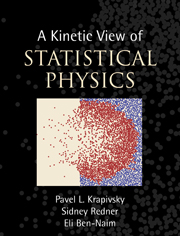3 - Collisions
Published online by Cambridge University Press: 05 March 2013
Summary
Non-equilibrium statistical physics courses usually begin with the Boltzmann equation and some of its most prominent consequences, particularly, the derivation of the Navier–Stokes equation of fluid mechanics and the determination of transport coefficients. Such derivations are daunting, often rely on uncontrolled approximations, and are treated in numerous standard texts. A basic understanding can already be gained by focusing on idealized collision processes whose underlying Boltzmann equations are sufficiently simple that they can be solved explicitly. These include the Lorentz gas, where a test particle interacts with a fixed scattering background, and Maxwell molecules, where the collision rate is independent of relative velocity. We also present applications of the Boltzmann equation approach to granular and traffic flows.
Kinetic theory
Non-equilibrium statistical physics originated in kinetic theory, which elucidated the dynamics of dilute gases and provided the starting point for treating more complex systems. Kinetic theory itself started with the Maxwell–Boltzmann velocity distribution, which was found before the Boltzmann equation – whose equilibrium solution is the Maxwell–Boltzmann distribution – had even been formulated.
The Maxwell–Boltzmann distribution
Let's start by deriving the Maxwell–Boltzmann velocity distribution for a classical gas of identical molecules that is in equilibrium at temperature T. Molecules scatter elastically when they are sufficiently close due to a short-range repulsive intermolecular potential. Let P(v)dv be the probability to find a molecule within a range dv about v.
- Type
- Chapter
- Information
- A Kinetic View of Statistical Physics , pp. 59 - 102Publisher: Cambridge University PressPrint publication year: 2010



